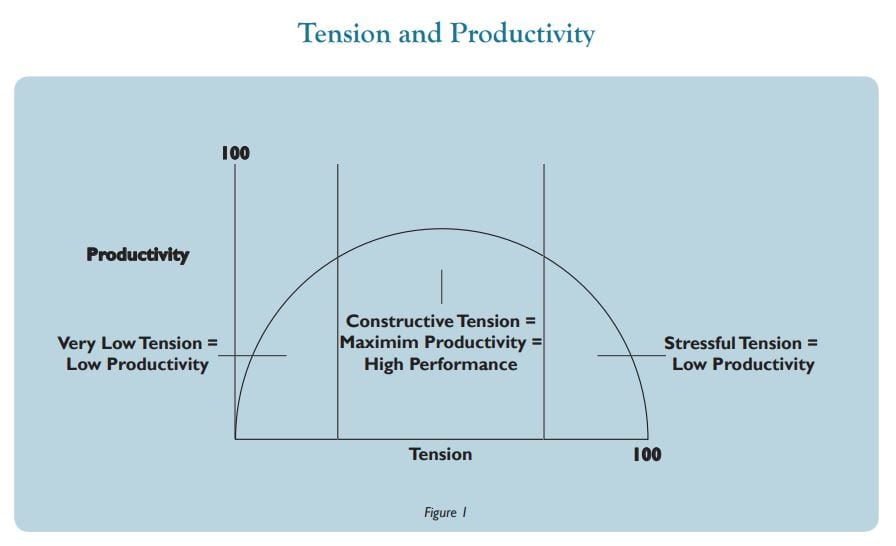Did you know that there are positive and negative tensions in the workplace? And that if you as a leader regulate it properly, the result is effective tension, which can generate increase productivity? It’s all part of making Common Sense Common Practice. Learn how to achieve effective tension and its benefits in this article.
Common Sense Test
Let’s start with a little test.

Use your common sense to determine if the following assumptions are true or false.
1. You cannot empower incompetent people.
2. Employees work harder when they believe management is interested in their welfare.
3. When a person takes a risk and succeeds, the experience is energizing.
4. Tension improves performance until a certain level is reached. Then, performance deteriorates.
5. When workers are rewarded for individual performance, they are less likely to collaborate.
6. People tend to resist change when it threatens their security.
7. As a result of downsizing and re-engineering, trust within organizations is eroding rapidly.
8. Behavior that is rewarded tends to be repeated.
9. As you rise in the organization, you receive less and less reliable feedback.
10. Habits that have been rewarded for years are more difficult to break.
(Answers at the end.)
Common-Sense Leadership – The Key to High Performance
All of the assumptions in our Common Sense Quiz may seem basic. Actually, each statement is based upon a well-tested psychological principle, like Maslow’s hierarchy of needs, the Yerkes-Dodson law, psychology’s law of effect, the Hawthorne effect, Herzberg’s two-factor theory, and even a few of our own. But, don’t let the names intimidate you. These are simple, verifiable ideas — the kind of assumptions you make every day about the people you work with.
Each of these concepts is an example of what we call tested common sense, assumptions made about human nature that have been empirically verified through psychological research or through actual application in the real-world workplace.
Unfortunately, many leaders underestimate the effectiveness of common sense in today’s business environment. Instead, many grasp at “the next big idea,” some new formula for success that seems more contemporary or novel. More often than not, though, these management fads and gimmicks quickly pass from the scene. But, common sense is more permanent, and will help you deal with people issues today, tomorrow, next year . . . no matter what changes lie ahead.
Trust your common sense and pay heed to it when making leadership decisions. Most of what you know about human behavior comes from the “basic psychology” that you’ve picked up through your experiences in life. As a leader, your common sense can help you make sound judgments about the likely impact of your decisions and actions, as well as help you anticipate how others will react to them.
Tension Management
One of the primary common-sense principles we advocate is: The main job of the leaders in any organization is to manage productivity by regulating the level of tension within the organization.
The Meaning of Tension
The term “tension” is not a synonym for “stress.” Stress is a negative, nonproductive feeling of anxiety and strain, usually surfacing when people are put under pressure for extended periods of time. Unlike stress, tension can generate productive energy. For example, the tension that actors or athletes experience while preparing to perform can actually provide an edge which heightens their performance. Still, at first glance, the idea of regulating tension may seem to require more than basic common sense; but let’s take a closer look.
Causes of Tension in an Organization
First of all, common sense tells us that tension exists in any organization. In addition to the predictable road bumps, every organization faces unpredictable challenges that produce tension: recalls, price increases, lagging sales, restructuring, new technology, labor troubles, tight money, fires, or other disasters — anything that can threaten the people, profits, or operations of a company.
Internal forces also produce tension. An accountant’s goals may conflict with those of the quality control department. Likewise, quality control may pursue outcomes that clash with manufacturing. Whenever gaps exist between what people in the organization want and what they have, tension results.
Is Tension Positive or Negative

Figure 1 illustrates how the level of tension affects productivity. Notice that whether tension hovers at low levels or rises toward the high end, the results are the same: performance drops dramatically. But when tension is in the middle, productivity peaks. This is effective tension.
Negative Tension
Low Tension Causes Inertia
When the tension level remains too low, inertia rules. Employees and leaders may not feel compelled to achieve productivity goals. The whole organization may appear almost apathetic about responding to the market, competitors, or its customers. Jobs seem secure no matter how people perform. Employees feel entitled to job benefits, which often grow lavish over time.
Managers may either be aloof or completely accommodating and forgiving. No one has a desire to upset the status quo. No pressure. No risk-taking. No energy. In short, without tension, little happens. The Low-Tension Organization can be successful only as long as it has a monopoly on its market, product, or technology.
High Tension Causes Stress
Then there’s the High-Tension Organization, which operates in a stressful, crisis mode that can paralyze workers. Instead of focusing energy, high tension dissipates it. Here, employees are on edge, defending themselves against a sense that their efforts have no effect on what happens to the organization or on the unrelenting pressure they feel.
Self-preservation is their primary motive. They refuse to take risks. They withdraw, protecting their emotions and self-confidence from further assaults. People in high-tension organizations eventually stop caring and shut down.
Clearly, neither low nor high tension is effective tension.
Positive Tension
In the middle, we find the optimum tension level. Here, leaders have found a way for workers to make a direct correlation between their efforts and the productivity, profitability, and overall success of the organization. The tension level is high enough to challenge and motivate, but not so high as to be overly stressful. People see that their pay, benefits, and job security come through their own individual and collective efforts. They are personally aware of what they need to do to keep the organization competitive. This is effective tension.
Healthy Tension
Common sense tells us that if a leader wants to foster high performance, he/she must keep the level of tension between the two extremes, where productivity hits its peak. Today, a leader must act as a thermostat of sorts, responsible for keeping tension at optimum levels and making adjustments when the level is too high or too low. Leaders at all organizational levels must be tension thermostats.
Why Do Engagement and Productivity Vary Between Companies?
Why is it that one organization seems tired and immobile, its attitude toward change seemingly embalmed in apathy? How is it that another organization is frantic and distressed, its people easily derailed and almost hysterical much of the time? Why is still another organization able to take on one challenge after another, its leaders and workers energized in their enthusiasm to prevail?
Effective Tension is the Difference
In every case, the difference is the extent to which leaders are aware of tension and able to use common sense to regulate it. After all, there is little you can do about the chaos to which you and your people are subjected. But, in your leadership role, you can and should be helping manage the tension level within your organization.
All of the statements in the Common Sense Test are true.
Additional Resources
For more on this topic, see the web page on our book, Making Common Sense Common Practice. You’ll find the first chapter of the book, and info if you’d like to purchase a copy.
Feel free, of course, to contact us if we can be of help on this topic.
Download This Effective Tension Whitepaper
To receive a copy of this whitepaper, please complete the form below and we will email it to you.












